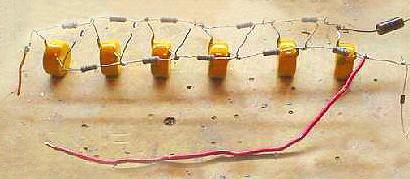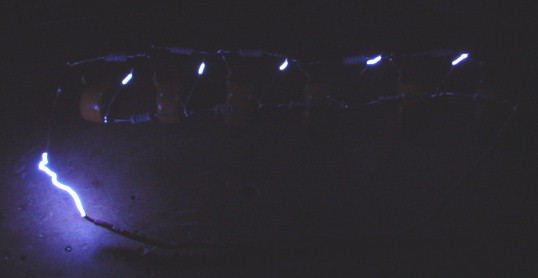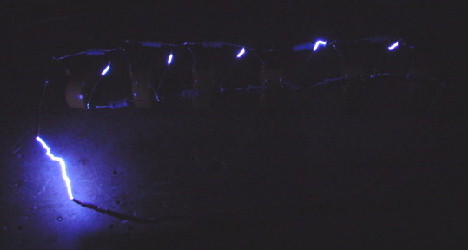Marx Generator
Return to Home
Return to Projects

There are six stages using .002uF 20kV ceramic disc capacitors and 1Meg ohm resistors between each stage. The transformer is a 9kV 30mA neon transformer that is rectified by a string of ten 1N4007 diodes for a 10kV 1A rectifier rating. The DC charges up the generator and when it fires, makes loud 1.5-inch snapping arcs. This Marx generator fires once every 2 to 3 seconds.

The Marx generator



1.5" Sparks
The "quick and dirty" marx generator shown above was rebuilt in a slightly neater manner on a small wooden platform. It now runs off a compact high voltage generator consisting of a 555 timer oscillator that drives a HV transistor that drives a small modern TV flyback capable of providing about 12kV to 20kV. Below is a schematic diagram of the updated marx generator with the new HV generator.

The transistor I used was found in a junk pile and is rated around 400V 8A. However, the transistor and the big heatsink got very hot while operating over 30 seconds so I added a small laptop fan on top of the heatsink. 2.2Meg 1W resistors were used between the capacitors. No external rectifiers were necessary since the modern flyback already has diodes are built in and provides DC. This generator fires about once every second. I could push this generator to give over 3 to 4 inch arcs, but then the resistors start arcing and the leads on the capacitors sometimes arced so the arc distance was backed off to to 2.5 inches and it performed well without problems. Applying silicone caulking around the resistors helps some. Below is a picture of the updated marx generator in operation. It fired twice while the camera's shutter was open so there are two arcs in the picture.

Below a video that I recorded in summer 2024, about 20 years after building this project (YouTube didn't exist back then!). The sparks are hard for a camera to record because they flash and disappear very fast.